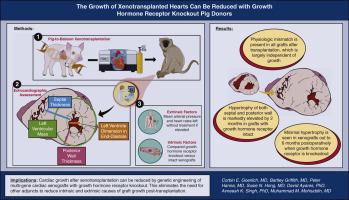The Journal of Thoracic and Cardiovascular Surgery ( IF 6 ) Pub Date : 2021-09-04 , DOI: 10.1016/j.jtcvs.2021.07.051 Corbin E Goerlich 1 , Bartley Griffith 2 , Peter Hanna 3 , Susie N Hong 3 , David Ayares 4 , Avneesh K Singh 2 , Muhammad M Mohiuddin 2

|
Objective
Genetically engineered pigs are thought to be an alternative organ source for patients in end-stage heart failure unable to receive a timely allograft. However, cardiac xenografts exhibit growth and diastolic heart failure within 1 month after transplantation. Grafts function for up to 6 months, but only after administration of temsirolimus and afterload-reducing agents to reduce this growth. In this study we investigated the growth and hemodynamics of growth hormone receptor (GHR) knockout xenografts, without the use of adjuncts to prevent intrinsic graft growth after transplantation.
Methods
Genetically engineered pig hearts were transplanted orthotopically into weight-matched baboons between 15 and 30 kg, using continuous perfusion preservation before implantation (n = 5). Xenografts included knockout of carbohydrate antigens and knockin of human transgenes for thromboregulation, complement regulation, and inflammation reduction (grafts with intact growth hormone, n = 2). Three grafts contained the additional knockout of GHR (GHR knockout grafts; n = 3). Transthoracic echocardiograms were obtained twice monthly and comprehensively analyzed by a blinded cardiologist. Hemodynamics were measured longitudinally after transplantation.
Results
All xenografts demonstrated life-supporting function after transplantation. There was no difference in intrinsic growth, measured using septal and posterior wall thickness and left ventricular mass, on transthoracic echocardiogram out to 1 month in either GHR knockout or GHR intact grafts. However, hypertrophy of the septal and posterior wall was markedly elevated by 2 months post transplantation. There was minimal hypertrophy out to 6 months in GHR knockout grafts. Physiologic mismatch was present in all grafts after transplantation, which is largely independent of growth.
Conclusions
Xenografts with GHR knockout show reduced post-transplantation xenograft growth using echocardiography >6 months after transplantation, without the need for other adjuncts.
中文翻译:

生长激素受体敲除猪供体可以减少异种移植心脏的生长
客观的
基因工程猪被认为是无法及时接受同种异体移植的终末期心力衰竭患者的替代器官来源。然而,心脏异种移植物在移植后 1 个月内表现出生长和舒张性心力衰竭。移植物的功能长达 6 个月,但仅在使用替西罗莫司和后负荷减轻剂以减少这种生长后才能发挥作用。在这项研究中,我们调查了生长激素受体 (GHR) 敲除异种移植物的生长和血流动力学,没有使用辅助剂来防止移植后的内在移植物生长。
方法
基因工程猪心脏被原位移植到体重在 15 到 30 公斤之间的狒狒体内,在植入前使用连续灌注保存 (n = 5)。异种移植物包括碳水化合物抗原的敲除和用于血栓调节、补体调节和炎症减少的人类转基因的敲入(具有完整生长激素的移植物,n = 2)。三个移植物包含额外的 GHR 敲除(GHR 敲除移植物;n = 3)。每月两次获得经胸超声心动图,并由不知情的心脏病专家进行综合分析。移植后纵向测量血流动力学。
结果
所有异种移植物在移植后都表现出维持生命的功能。在 GHR 敲除或 GHR 完整移植物中,使用间隔和后壁厚度以及左心室质量测量的内在生长没有差异,经胸超声心动图显示 1 个月。然而,隔膜和后壁的肥大在移植后 2 个月明显升高。GHR 敲除移植物在 6 个月后出现最小肥大。移植后所有移植物都存在生理错配,这在很大程度上与生长无关。
结论
具有 GHR 敲除的异种移植物使用超声心动图显示移植后异种移植物生长减少 > 6 个月,而不需要其他辅助手段。


























 京公网安备 11010802027423号
京公网安备 11010802027423号